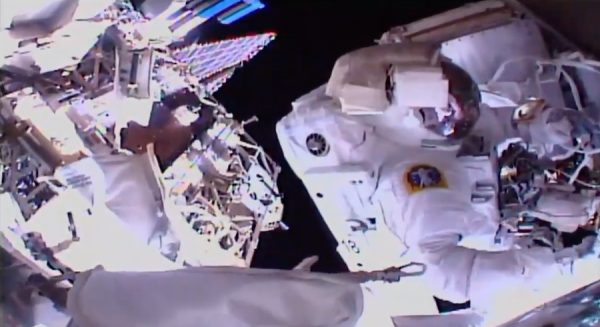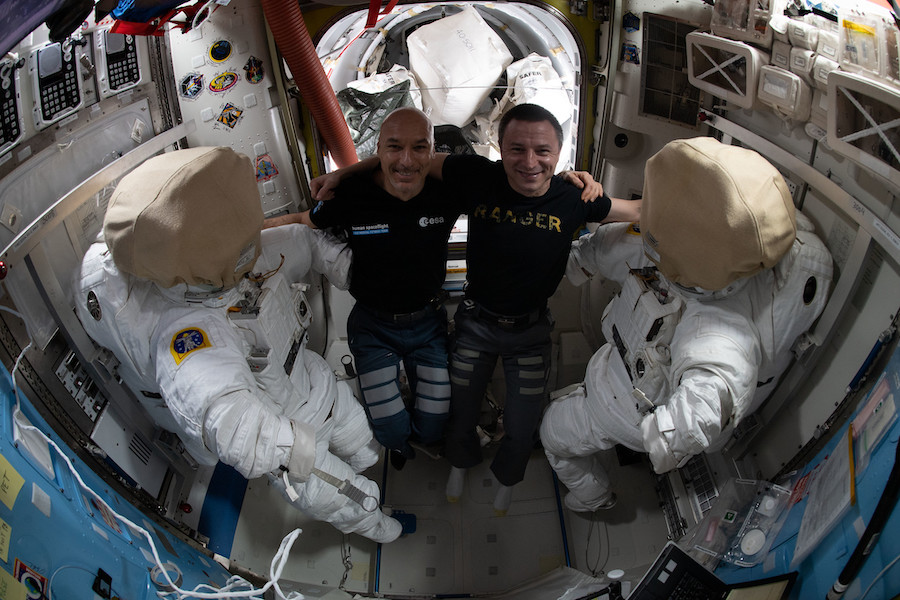Astronauts finish repairs to space station cosmic ray detector – Spaceflight Now
EDITOR’S NOTE: Updated at 1:40 p.m. EST (1840 GMT) after end of spacewalk.
STORY WRITTEN FOR CBS NEWS & USED WITH PERMISSION

During a fourth spacewalk Saturday to wrap up repairs of the coolant system in a $2 billion cosmic ray detector, Italian astronaut Luca Parmitano and Drew Morgan discovered a leak in one of eight coolant lines that were spliced into a new pump module during three earlier excursions.
Tightening up the suspect connector did not solve the problem. So Parmitano tried one more time before returning to the International Space Station’s airlock to retrieve a jumper and the tools needed to splice in a bypass if necessary, throwing a wrench into the crew’s carefully scripted spacewalk timeline.
But as it turned out, the bypass surgery was not needed. When he checked coolant line No. 5’s leak indicator a second time an hour later, a red line in a pop-out fitting was no longer visible, indicating he had successfully fixed the leak the second time he tightened the fitting.
“No red! No leak!” Parmitano exclaimed.
“OK, close it quick,” astronaut Jeremy Hansen replied from mission control. “Let us all take a breath down here and I’ll get back to you.”
And with that, all eight coolant lines in the Alpha Magnetic Spectrometer’s critical thermal control system were ready for normal coolant system pressurization. Parmitano and Morgan were told to press ahead with work to re-install insulation that was removed earlier to gain access to the instrument’s cooling system.
Morgan and Parmitano, the same spacewalking surgeons who carried out a tricky coolant pump transplant last December, began their fourth joint spacewalk at 7:04 a.m. EST, switching their spacesuits to battery power while still inside the station’s Quest airlock.
After exiting the airlock, Morgan and Parmitano gathered tools and double-checked safety tethers before heading for the 7.5-ton Alpha Magnetic Spectrometer, mounted on the top side of the station’s power truss just inboard of the lab’s right-side solar arrays.
Launched to the station in 2011 aboard the shuttle Endeavour, the AMS was built by an international team of researchers under the leadership of Nobel laureate Sam Ting. Using a 2,645-pound electromagnet, the instrument is designed to deflect electrically charged high-energy cosmic rays into an array of sensitive detectors.
The goal of the research is to learn what happened to the antimatter presumably created during the big bang in equal measure with normal matter; to shed light on the nature of the unseen dark matter making up nearly a quarter of the known universe; and to learn more about the mysterious “dark energy” that appears to be speeding up the expansion of the cosmos.
Originally designed to operate for just three years, the AMS chalked up eight years of operation before being sidelined by the sequential failures of four carbon dioxide coolant pumps. The coolant system is what allows the AMS detectors to achieve the required levels of sensitivity.
To repair the system and extend the instrument’s life through the end of the station program, engineers developed a four-spacewalk plan to install a custom-built 350-pound module containing four pumps and a reservoir of fresh carbon dioxide coolant.
The AMS was not designed to be serviced in space, making the work particularly challenging. But during spacewalks last Nov. 15, 22 and Dec. 2, Morgan and Parmitano opened up the AMS, removed insulation, snipped eight coolant lines, installed the new pump module and spliced, or “swaged,” the coolant lines back into place.
Special fittings were designed to pop open slightly, revealing a red line if the internal pressure indicated a leak. And that’s what the crew saw when they checked line No. 5 Saturday.
“Luca, I’ve gotta know, what made you pick (line) No. 5 first?” Hansen radioed from mission control later.
“It was the closest,” Parmitano replied.
“I was wondering if you had some sort of intuition or something.”
“Like I said, it’s almost better to be lucky than good,” Parmitano observed.
“There’s no other way to do that to create more drama than giving us that look on the first one,” Hansen said. “I think everyone’s heart stopped.”
“Yeah, I wonder what my flight surgeon saw on .. my heart rate,” Parmitano said. “It either flat lined or spiked, one of the two.”
Parmitano tightened up the fitting and then he and Morgan checked the other lines while waiting for a one-hour timer to expire. When checked again, the indicator in coolant line No. 5 still showed a leak.
“I’m sorry to report I do have a leak,” he said. “It looks like a large leak to me. (The indicator) is fully open.”
He then was asked to tighten up the fitting one additional turn and then, while waiting for another one-hour clock to tick down, return to the airlock to get a bypass jumper. But it wasn’t needed.
With the AMS repair work complete, the spacewalkers carried out a final “get-ahead task” — removing fogged filters from two external cameras — before heading back to the airlock to call it a day. The spacewalk ended at 1:20 p.m., for a duration of six hours and 16 minutes.

The unexpected work with coolant line No. 5 resulted in a few unusual lulls in the workflow, giving the spacewalkers a chance to marvel at the view of Earth more than 250 miles below during a night pass over Japan.
“I don’t know if you guys are just bored out there just killing time, but you can tell me, a non-spacewalker, what it looks like in a night pass, looking down on the planet?” Hansen asked. “What do you see?”
“I was going to ask you where we were, because I don’t think I’ve ever looked back down there at Earth during an EVA on a night pass,” Morgan replied. “I just turned my lights out, I’m out here in the inky black above the ISS. Looking down I can see … (we just) flew over a lot of great night lights.”
“It looks like you’re above the Sea of Japan just east of Asia there,” Hansen said.
“Yeah, it looked very heavily populated. So we’ll be over Japan then shortly?”
“I can already see it below me,” Parmitano chimed in
“Uh huh, there it is. Yep, I saw it, down to the Sea of Japan, we just passed it,” Morgan said. “You can see some fishing fleets out there in the Sea of Japan and then you can see the entire big island of Japan.”






